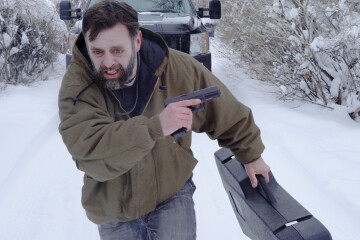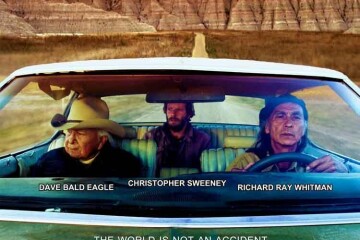Record-breaking Native Film Neither Wolf Nor Dog Explodes Across Big Sky Country
The success of Scottish director Steven Lewis Simpson’s adaptation of best-selling novel, Neither Wolf Nor Dog, defies logic—Hollywood logic that is. It was audience-financed with 18 shoot days, a tiny crew, a 95-year-old star and a self-distributed release that started in small towns and is outperforming Hollywood blockbusters in numerous multiplexes. It has a higher audience score on Rotten Tomatoes than any big Hollywood movie out at the moment: 4.7/5 - 95%. The film has had a longer theatrical run than any other U.S. film released in 2017 and has become the most successful non-Hollywood Native American film in years.
The film has steadily rolled out through the nation with a phenomenal 81 cinemas just between Montana, Oregon, Idaho, Washington, The Dakotas, and Minnesota and has remarkably passed the 135th theater mark within only 15% of the country. Recently, Oklahoma Film Critics Society’s Louis Fowler named Neither Wolf Nor Dog his number one film of 2017.
It’s had massive openings in Billings, MT where it was extended for 3 weeks and extended runs in Helena and Missoula. It currently is on extension in Whitefish and Havre, which has consequently lead to openings in Cut Bank and Polson to meet audience demand. In Bozeman, Neither Wolf Nor Dog will play on April 22 at the Rialto Theater and on April 25 at the Ellen Theatre as very special events.
In combination with the support of the Montanan communities and a sincere, heart-warming performance by the 95 year-old star, the film has had the biggest release of any small independent film in the state for quite some time.
The film is based on Kent Nerburn’s best-selling Native American novel “Neither Wolf Nor Dog”, which was first published in 1994 and won the Minnesota Book award in 1996. No other novel is seen to so successfully bridge the gap between white America and the Native American world. The story follows a white author who gets sucked into the heart of contemporary Native American life in the sparse lands of the Dakotas by a 95 year-old Lakota elder and his side-kick. Its humor is wry and pulls no punches, introducing deep characters and poignant vignettes that challenge the viewer to see the world differently.
For the 20 years since the novel was published, film producers circled it trying to make it into a movie. “It ended up having the reputation in Hollywood of being the great unmade, contemporary Native American novel,” one producer informed Simpson. Having had enough of empty Hollywood promises, author Kent Nerburn approached Steven Lewis Simpson at a screening of his movie Rez Bomb, shot on Pine Ridge Indian Reservation, and gave him the novel. For this director, this novel was too important for it to be subjected to the Hollywood treatment. Thus, the budget would be very low, essentially bankrolled by two successful Kickstarter campaigns, and made for less than the 11 2017 summer blockbusters’ Porta Potty budgets.
Dave Bald Eagle plays Dan, a Lakota elder with a laconic manner and a wry twinkle in his eye. He is rough-edged and earthy, but very astute and watchful. He sees through the artifice of others with unerring accuracy. He is also a deep thinker who has reflected long and hard on the traditions, beliefs, and plight of the Native peoples. Somewhere in his wry and watchful manner is the faint echo of a deep and inconsolable sadness.
Bald Eagle died at the age of 97 in 2016 before the film’s release. For a time, his obituary was the most-read feature in the world on the BBC. NPR’s All Things Considered team debated on-air whether he was “the world’s most interesting man.” Bald Eagle was born in a tipi in 1919 and spoke only Lakota until he went to school at 12 years old. Many historians wildly speculated his grandfather, White Bull, killed General Custer at the Little Bighorn. During WW2, he was a paratrooper with the 82nd Airborne, jumping behind the lines at Anzio; on D-Day they were mistakenly dropped over German lines. Riddled with bullets before he hit the ground, he was left for dead by the first medics that found him, but British commandos found a pulse and helped him survive. The film’s climax was filmed at Wounded Knee, and Dave improvised the whole sequence in the most moving way. Afterwards, he said “I’ve been holding that in for 95-years.” This wasn’t your average movie shoot.
Christopher Sweeney plays Kent Nerburn, a goodhearted, socially conscious, family man who has worked with the Ojibwe on the reservations of northern Minnesota. He is the best of the “white liberal” – caring, committed, and willing to serve and meet the needs of others.
Richard Ray Whitman, a Yuchi- Muscogee/Creek artist, poet, actor and activist, portrays Grover, a Lakota in his sixties who is Dan’s friend, confidant, and protector.
Canadian film and television actress Roseanne Supernault jumped at the opportunity to portray both of Dan’s twin granddaughters, Wenonah and Danelle. The directors bold decision to have her in both roles paid off in a big way, as he described her acting as “formidable.”
Tatanka Means, son of Russell Means who was the most famous American Indian Activist of the 20th Century, was Simpson’s first choice for Delvin in the film. Tatanka’s strength and dignity shine through in his character.
Raised near Browning, Montana, native Zahn McClarnon (Fargo, Longmire) co-stars in the film as Billy, and also helped to produce the movie.
Author Kent Nerburn says of the film “in both its choices that reflect the book and its choices that go outside the book, is always uncompromisingly respectful and accurate in its depiction of Native people and life. To my mind, there is not one false note in the portrayal of Native reality. I can say, with pride, that I have never seen any film, created by Natives or non-Natives, that brings the viewer closer to the experience of a journey through reservation life. We simply refused to compromise on this aspect, and in our refusal to compromise, we found our common ground.
Yes, Steven changed the book. Yes, he adapted it; yes, he augmented it. But he nailed it. The choices he made were exquisite. His film is at once different from the book and better than the book. The story you see on the screen may differ from the book you saw in your mind. In many ways, it differs from what I saw in mine. But, in an act of astonishing creative transformation, one stubborn, incredibly talented man with a camera did something I did not think was possible: he made a completely new work of art that honored the original work of art while carrying it to a new level. He took my literary child and made a man of it. I am pleased and honored and grateful, and I believe you will be, too.”
Omotola Lajubutu is the Film Distribution & Media Coordinator for InYo Entertainment. Angie Ripple is publisher at Bozeman Magazine and adapted PR from Omotola for this piece.

